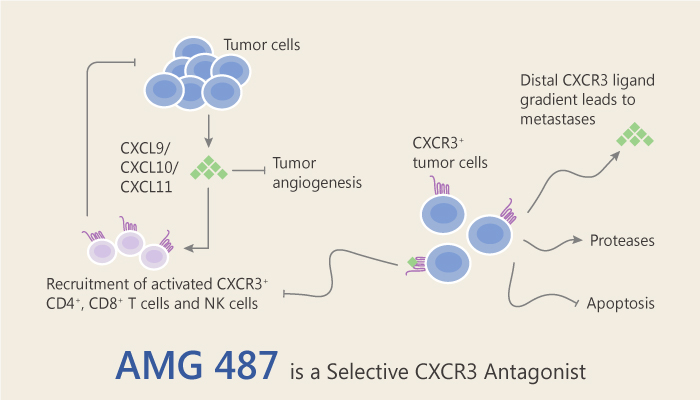Chemokine receptor CXCR3 is a chemokine receptor primarily expresses on activated CD4+ and CD8+ T cells with a Th1 phenotype. CXCR3 also expresses on B cells, natural killer (NK) cells, malignant T cells, and astrocytes. The ligands for CXCR3 are Mig (CXCL9), IP-10 (CXCL10), and ITAC (CXCL11). IFN-c induces these ligands. Especially, macrophages as well as other cell types in inflamed tissue produce these ligands. Gratifyingly, CXCR3 and its ligands have been implicated in a number of inflammatory diseases including rheumatoid arthritis, multiple sclerosis, inflammatory bowel diseases, psoriasis, and transplant rejection. CXCR3 ligands that attract Th1 cells can concomitantly block the migration of Th2 cells in response to CCR3 ligands, thus enhancing the polarization of effector T cell recruitment. Therefore, blockade of CXCR3 may play a beneficial role in the treatment of these inflammatory diseases.
In this study, to test the hypothesis that tumor metastasis is facilitated by CXCR3 expressed by tumor cells, researchers employ an antagonist of CXCR3, AMG 487. Further evaluation of AMG 487 demonstrated that, in addition of inhibiting 125I-IP-10 binding, AMG 487 also inhibits binding of 125I-ITAC to CXCR3 with an IC50 value of 8.2 nM. Moreover, evaluation of AMG 487 in in vitro functional assays demonstrates that AMG 487 inhibits CXCR3-mediated cell migration by the three CXCR3 chemokines (IP-10 IC50=8 nM, ITAC IC50= 15 nM, and MIG IC50=36 nM). Furthermore, AMG 487 inhibits calcium mobilization in response to ITAC (IC50=5 nM).

All in all, AMG 487 is a chemokine receptor 3 CXCR3 antagonist with antimetastatic effect. Blockade of CXCR3 may play a beneficial role in the treatment of many diseases.